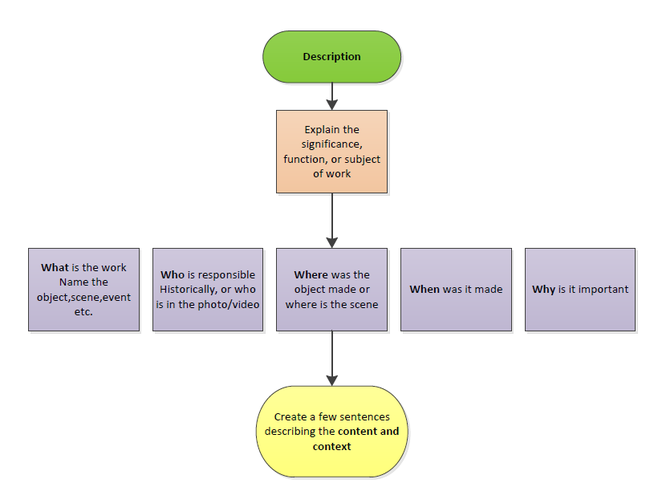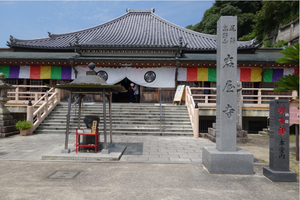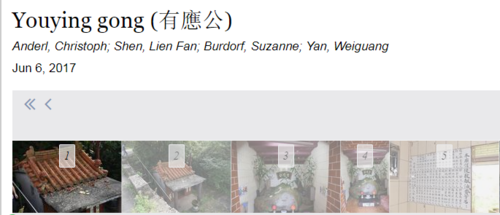Documentation:Library:Circle/FROGBEAR Description metadata
Overview
This document describes the rules and process of filling in the description field. The below graphic explains how to create descriptions for varying items.

Guidelines for Description
The description field or element consists of a brief note (a few sentences), detailing the content and context of the text, photo, video, or audio file. It is a free-text field used to record information that may supplement, qualify, or further explain some of the other elements such as Title, Spatial coverage, etc. How much information should be included depends upon several factors, including the types of materials being documented and the function, role, and purpose served by the documentation. Imagine that your audience is not a subject matter expert but will use the information you provide to understand the context and significance of what you are describing, and to identify opportunities to learn more about the site, object, individual, etc.
Consistency of terminology is preferable. Consistent style, grammar, and sentence structure are recommended.
The note can include info such as characteristics (of an object, building or setting), historical significance or function of the work of art or architecture.
The field may also be used to cite a particular publication as the source of info about the work.
EXAMPLE
- [for an ancient Egyptian bas relief]
- Mentuhotep II was the founder of the Middle Kingdom, … This relief comes from his mortuary temple at Deir el-Bahri in western Thebes. …
Source: Hibbard, Howard. Metropolitan Museum of Art. New York: Harrison House, 1986; Page: 30.
Brief Rules for Description
Explain the significance, function, or subject of the work.
- Enter information clearly and concisely. Capture important points not already fully described in other elements.
- Use complete sentences
- List info from general to specific, depending on which is appropriate
It may be helpful to formulate the Description by thinking of listing info in this order:
- What is the work? Name the object, scene, event, etc.
- Who is responsible for it (historically?) or who is in the photo, video, audio?
- Where was the object made or where is the scene/event happening?
- When was it made?
- Why is it important? Is there a special significance?
Omit any of these questions if they are not relevant, significant, or are explained adequately in other elements.
Use sentence case and capitalize proper names. Avoid abbreviations.
EXAMPLE
FROGBEAR example in Open Collections

Description: Details of the wooden column, beams, brackets, and roof support of the Great Hall of the Three Clarities (Sanqing dadian 三大清殿) in the Fengxian guan 奉仙觀, a Daoist temple in Jiyuan, Henan, China. This five-bay wide hall is the main building of the temple complex, and the oldest, dating to 1184 (the first temple on the site was built in 685). The massive wooden beams and brackets are largely original. The walls and roof have been repeatedly renovated. The plaques on the beams and columns, added in the early twentieth century, describe the provenance and nature of the material used and its structural roles. They may date to a visit by the architectural historian Liu Dunzhen 劉敦楨 (1897-1968).
- [for a Maya pot]
- This straight-sided ceramic vessel with painted decoration comprising complex scenes was a common type in 8th-century Maya art. The codex-style painting depicts a scene in the realm of the Lords of Death, where a dancing figure holds a long-handled axe and a handstone. On a monster-head altar lies Baby Jaguar, a deity figure, and beside the altar is a dancing skeletal death figure. The meaning has been variously interpreted as depicting either sacrifice or celebration.
Write the note in English. Names and other words in East Asian languages may be used within the note. Use Romanization and diacritics as appropriate.
E.g., Small shrine within Takuhi Shrine (Takuhi jina 焼火神社) precincts
EXAMPLE
- [for an Indian sculpture]
- Chola-period bronzes were created using the lost wax technique, meaning that each sculpture is unique. Parvati wears her signature conical crown with karandamukuta tiers, and she stands in the tribhanga, or triple-bend pose. …
Descriptions for Multiple Objects
Descriptions of multiple objects such as directional views of a statue should be numbered. If you wish to reference specific images in the description, add sequential numbers to the end of the filename, separated with an underscore, and use those numbers the description.
EXAMPLE
Abstract: Description of first image [1]. Description of second image [2].
File name: defaultfilename_1.jpg || defaultfilename_2.jpg
FROGBEAR EXAMPLE in Open Collections

Description: Roof [1]. Surrounding view [2]. Altar in the form of rock (有應公) [3]. Long shot of the altar [4]. Donor ledger [5].
References
Adapted from: Cataloging cultural objects : a guide to describing cultural works and their images. Chicago: American Library Association, 2006.